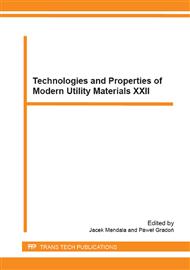[1]
C.P. Doğan, J.A. Hawk, Role of zirconia toughening in the abrasive wear of intermetallic and ceramic composites, Wear 212 (1997) 110-118.
DOI: 10.1016/s0043-1648(97)00114-2
Google Scholar
[2]
A. Senthil Kumar, A. Raja Durai, T. Sornakumar, Machinability of hardened steel using alumina based ceramic cutting tools, Int. Journal of Refractory Metals & Hard Materials 21 (2003) 109-117.
DOI: 10.1016/s0263-4368(03)00004-0
Google Scholar
[3]
A.Z.A. Azhar, H. Mohamad, M.M. Ratnam, Z.A. Ahmad, The effects of MgO addition on microstructure mechanical properties and wear performance of zirconia-toughened alumina cutting inserts, Journal of Alloys and Compounds 497 (2010) 316-320.
DOI: 10.1016/j.jallcom.2010.03.054
Google Scholar
[4]
Y. Zhou, H. -X. Zhai, Z. -Y. Huang, M. -X. Ai, Z. -L. Zhang, S. -B. Li, C. -W. Li, Influence of Toughening Method on Microstructures and Mechanical Properties of Alumina-Matrix Composites, Materials Science Forum 475-479 (2005) 909-912.
DOI: 10.4028/www.scientific.net/msf.475-479.909
Google Scholar
[5]
F. Kern, R. Gadow, Pressureless sintered silicon carbide containing ZTA, Proc. 10th ECERS Conference, Baden-Baden (2007) 1071-1077.
Google Scholar
[6]
F. Kern, R. Gadow, Manufacturing of hot-pressed and pressureless sintered ZTA-SiC nanocomposites, Proc. CIEC11, Lausanne (2008) 1-8.
Google Scholar
[7]
I.W. Chen, X.H. Wang, Sintering dense nanocrystalline ceramics without final-stage grain growth, Nature 404 (2000) 168-171.
DOI: 10.1038/35004548
Google Scholar
[8]
K. Maca, V. Pouchly, P. Zalud, Two-step sintering of oxide ceramics with various crystal structures, J. Eur. Ceram. Soc. 39 (2010) 583-589.
DOI: 10.1016/j.jeurceramsoc.2009.06.008
Google Scholar
[9]
D.M. Hulbert, D. Jiang, D.V. Dudina, A.K. Mukherjee, The synthesis and consolidation of hard materials by spark plasma sintering, Int. Journal of Refractory Metals & Hard Materials 27 (2009) 367-375.
DOI: 10.1016/j.ijrmhm.2008.09.011
Google Scholar
[10]
K. Niihara, A fracture mechanics analysis of indentation-induced Palmqvist crack in ceramics, J. Mater. Sci. Lett. 2 (1983) 221-223.
DOI: 10.1007/bf00725625
Google Scholar
[11]
J.X. Chen, Y.C. Zhou, H.B. Zhang, D.T. Wan, M.Y. Liu, Thermal stability of Ti3AlC2/Al2O3 composites in high vacuum, Materials Chemistry and Physics 104 (2007) 109-112.
DOI: 10.1016/j.matchemphys.2007.02.091
Google Scholar


